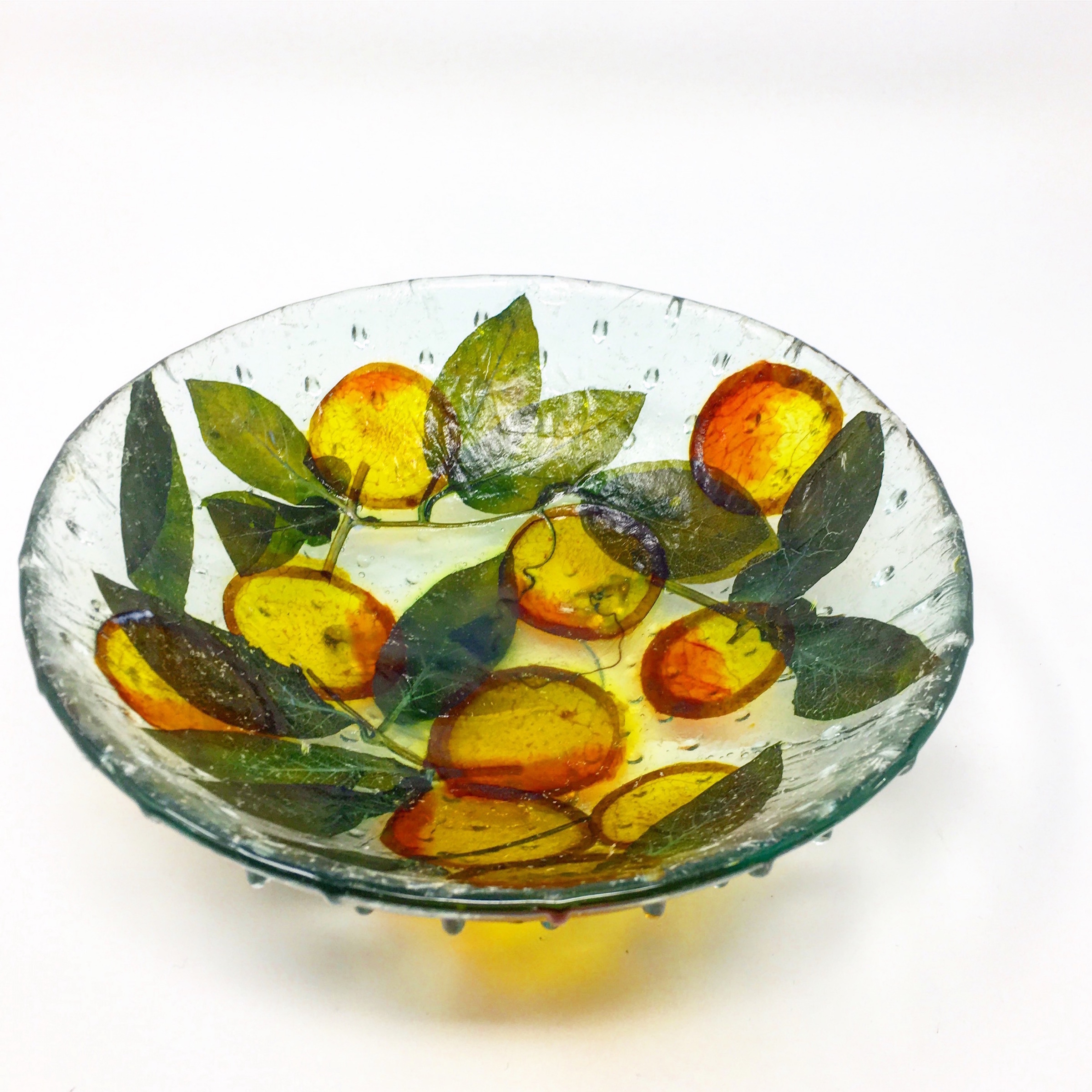Meet the Maker: Margaret Dorfman
California-based artist Margaret Dorfman transforms fruits and vegetables into translucent parchments that are shaped into vessels, glass serving ware pieces, and fused to copper to form jewelry. Her Vegetable Parchments capture and preserve the jewel-like colors and intricate structures in stunning detail, and her work is at our Museum Shop!
We asked Margaret to answer a few questions about her artistic practice and inspiration. Read on to learn more about Margaret’s fascinating work, and be sure to register for the Museum Shop Holiday Mart to have the opportunity to add one of her works to your collection or to purchase as a gift for a loved one.
What is the first thing you can remember making?
I can’t remember the first thing I made, nor can I remember a time when I wasn’t making something-whether it be tiny houses for fairies, a tea set made from leaves, or a fern bed for a stuffed animal. Making things with my hands was something I always did when I had free time. I was fortunate to grow up in a rural area and realized early that the best materials for making things – like acorns, bark, moss, and feathers – weren’t found in store.
Could you describe the process behind making your fruit and vegetable parchment works?
My work is made by hand from over forty different varieties of fresh fruits and vegetables that are cured, dried, pressed and aged in a ten-to-fourteen-day process. The translucent parchments that result preserve the jewel-like colors and intricate structures that are characteristic of each fruit or vegetable. I call this vegetable parchment because the texture and translucency call to mind the vellum parchments of medieval Europe.
The parchments are formed into vessels for decorative bowls, embedded into glass for food-safe platters and plates. They are fused to copper or folded into fanciful flowers with gemstones, and gilded with gold to make necklaces, earrings, and cuffs.
Just recently, some of my shelter-in-place time has been spent pressing fruit and vegetables into silk fibers to make colorful, pure silk scarves. Slices of fruit and vegetables are pressed into the silk a using over 200 tons of pressure for about two weeks. Shadowy images of the fruits and vegetables are permanently embedded into the fibers. The scarves are washable and color-fast.
When did you begin creating the vegetable parchment glass serving pieces?
I loved making the decorative vegetable parchment vessels, but I wanted to make something that was a little more functional. Customers were asking for this too. So, I set out to find a way to make useable, food-safe serving pieces. I like the idea of using a clear glass that would showcase the color and translucency of these fruits and vegetables. Using recycled glass was important to me too, and I was just delighted when I found these glass pieces from Greece.
Over the better part of a year, I learned how to use this glass frit, a sand-like substance that melts into glass, and a torch. The fruits and vegetables could now be embedded in glass. It took lots of trial and error, but I finally came up with something that worked beautifully.
Using recycled glass pieces from Greece, fruits and vegetables are sealed into the glass plate with a additional layer of glass applied to the top of the plate .This embeds the fruits and vegetables in glass, creating a long lasting hand washable, food-safe surface.
I am also able to now incorporate varieties of produce in the serveware that I can’t use in the vessel/bowl pieces, like tomatoes, raspberries, and plum. The glass serving pieces come in a wide variety of plates, platters and bowls ranging from large oval and rectangular centerpiece size, to small condiment dishes. They can be used to serve food or for keys, mail, cuff links, soaps or other small treasures.
What drew you to working with unconventional materials?
I think this hearkens back to my tendency to make use of the things I see around me as the “raw materials.” But more than that, I think it was seeing the beauty that was intrinsic to the fruit and vegetables themselves that drew me.
I think it is natural to take for granted the beauty in things we see every day, like fruit and vegetables. The complex structure and rich glowing colors deserve a closer look. And, each type of fruit and vegetable is so different – in structure, shape, and color and texture. I call them commonplace wonders. Because they are ubiquitous, they are so easy to overlook. For example, bok choy is reminiscent of marble with its dark and creamy white striations. Pear has sandpaper feel contrasted by smooth, shiny skin. The subtle shading of orange to flame-colored red in a Mexican papaya always reminds me of a sunset. Broccoli looks like a moss green miniature forest of tiny trees. Beet has a burgundy color that almost glows, and the rich, saturated reds and yellows in bell peppers look almost like colored vinyl.
The seasonal beauty of fruits and vegetables is fleeting. I wanted to capture and hold this beauty creating objects that we could wear, use, and see everyday.
Is one fruit or vegetable more challenging than the others?
Failures for me are still grapes, tomato, lychee and radicchio. These don’t have the fiber structure required for a bowl. I haven’t been happy with the results working with some types of berries either, like blackberry and boysenberry; these are too dense.
However, I have been able to incorporate some of these varieties into the both the glass serving pieces, jewelry, and the scarves!
Describe for us the atmosphere when you are at work?
While working, I usually listen to NPR or a book on tape. My studio was built for me with built-in wood drawers, white walls and shelves. I have a special room with the drying cabinets and an industrial-sized fridge to store the more fragile fruits and vegetables
I do the glassware outside. We have a nice garden that is regularly visited by hummingbirds and squirrels. On nice days, my parrot keeps me company in his aviary.
What is the most fulfilling part about your work?
Being able to earn a living doing something I enjoy so much. Almost every day, there are new discoveries and surprises. Different variations of the same fruit or vegetable can react in very different ways, like a purple potato unexpectedly turning shades of teal and turquoise. There are so many new varieties of fruit and vegetables to work with. I’m now experimenting with cultivated mushrooms, dragon fruit in pink, yellow, and white varieties, breadfruit, and the horned Kiwano melon.



